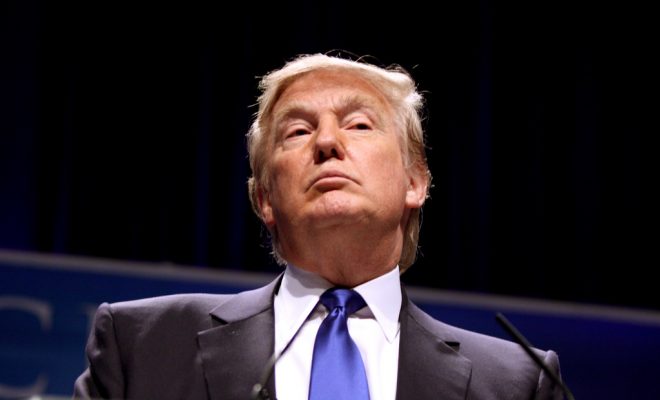 Image Courtesy of Gage Skidmore; License: (CC BY-SA 2.0)
Image Courtesy of Gage Skidmore; License: (CC BY-SA 2.0)
Technology
Can Twitter Ban Donald Trump for Cyberbullying?
The internet is a powerful tool. It can be used to spread information quickly, to answer any question instantly, and to share photos of vacations.
But the internet can also be a powerful platform where unsavory things can flourish. All the benefits of being able to spread information quickly and share photos can be used negatively. When these sorts of things are directed at a specific person or group, it is called “cyberbullying.”
Stop Bullying, a website dedicated to spreading awareness about bullying, defines cyberbullying as:
bullying that takes place using electronic technology. Electronic technology includes devices and equipment such as cell phones, computers, and tablets as well as communication tools including social media sites, text messages, chat, and websites. Examples of cyberbullying include mean text messages or emails, rumors sent by email or posted on social networking sites, and embarrassing pictures, videos, websites, or fake profiles.
“Troll-in-Chief”
Recently, President Donald Trump attacked “Morning Joe” co-hosts Joe Scarborough and Mika Brzezinski on Twitter, saying:
I heard poorly rated @Morning_Joe speaks badly of me (don’t watch anymore). Then how come low I.Q. Crazy Mika, along with Psycho Joe, came..
— Donald J. Trump (@realDonaldTrump) June 29, 2017
…to Mar-a-Lago 3 nights in a row around New Year’s Eve, and insisted on joining me. She was bleeding badly from a face-lift. I said no!
— Donald J. Trump (@realDonaldTrump) June 29, 2017
This raised a lot of eyebrows and questions. One of the most serious questions raised was if Trump could be banned from Twitter for his behavior. John Cassidy of The New Yorker said that Trump will go down in history as the “Troll-in-Chief” because of his online behavior.
Sarah Huckabee Sanders, Trump’s spokeswoman, brushed off the criticism her boss was receiving. “This is a president who fights fire with fire,” Sanders explained. But where does self-defense end and cyberbullying begin?
Trump is the face of America to the rest of the world and his actions reflect on the entire country. More than that, as such a public and powerful figure, he is someone children will undoubtedly look up to. So with cyberbullying increasing in schools, it’s dangerous to have the commander-in-chief setting such a poor example for children.
Harmful Effects
The effects of cyberbullying can be serious. According to Stop Bullying, some of the effects cyberbullying can have on a victim include: alcohol and drug use, lower self-esteem, and health problems.
Cyberbullying happens a lot more frequently than you might think. In a 2016 report by the Department of Education, 20.8 percent of students ages 12 through 18 reported being bullied in the 2014-15 school year. The study found that 6.1 percent of male students experienced bullying online or through text message. 15.9 percent of females reported being bullied online or via text. The disparity between male and female is bad enough. But the numbers themselves show a growing problem.
Cyberbullying is different than other forms of bullying for a few reasons. First, it can occur at any time. A bully no longer needs a face-to-face interaction to inflict harm. Through the wonders of the internet, someone can be reached at any hour of the day via text, social media, email, or other channels on the internet. Next, the layer of anonymity can invite more bullying in perpetrators who normally would not have engaged in the act. An article Psychology Today published in 2013 said,
The ability to be anonymous might increase the likelihood that youths will engage in the behavior. Furthermore, a cyberbully does not necessarily see the reaction of the victim, making it easier to engage in mean behaviors.
Those who engage in cyberbullying are subject to certain anti-bullying laws. See how your state stacks up here. In 2012, Delaware became the first state to introduce a comprehensive cyberbullying policy to be adopted by public schools in the state.
As of 2017 every state has laws regarding cyberbullying, with most having both a policy and laws. Delaware’s policy was drafted by then-Lieutenant Governor Matt Denn and the late Attorney General Beau Biden. Here’s what Delaware’s policy says:
Incidents of cyberbullying shall be treated by each school district and charter school in the same manner as incidents of bullying, and notice of each school district’s and charter school’s policy against cyberbullying shall be provided to students, staff, and faculty in the same manner as notice of the school district’s and charter school’s policy against bullying.
This specific cyberbullying policy is intended for schools and how they can take action. But what about when cyberbullying takes place outside of a school setting?
Many websites have anti-harassment rules, though they can get tricky to enforce. Take the President of the United States, for example. On July 2, only a few days after the Morning Joe attack, he tweeted:
#FraudNewsCNN #FNN pic.twitter.com/WYUnHjjUjg
— Donald J. Trump (@realDonaldTrump) July 2, 2017
Many people have suggested that Twitter ban Trump for this behavior. Twitter’s rules explicitly say “You may not make threats of violence or promote violence, including threatening or promoting terrorism.”
But the social media giant has not banned the president. Yet. Banning the president is a big deal, but cyberbullying is a pretty big deal, too.








Comments